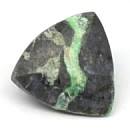|
ClassicGems.net |
|
|
 |
|
Annabergite |
|
|
Discovered in 1852; IMA status: Valid (pre-IMA; Grandfathered) |
|||
|
|
|
Chemistry |
|
|
|
|
|
Ni3(AsO4)2 • 8H2O |
|
|
|
Hydrated Nickel Arsenate |
|
Molecular Weight: |
598.03 gm |
|
Composition: |
Nickel |
29.44 % |
Ni |
41.48 % |
Ni2O3 |
|
|
Arsenic |
25.06 % |
As |
38.43 % |
As2O5 |
|
|
Hydrogen |
2.70 % |
H |
24.10 % |
H2O |
|
|
Oxygen |
42.81 % |
O |
|
|
|
|
|
100.00 % |
|
104.01 % |
= TOTAL OXIDE |
|
|
|
||||
|
Classification |
|
|
|
|
|
Arsenates |
|
|
7/C.13-80 |
|
|
|
8 : PHOSPHATES, ARSENATES, VANADATES
|
|
Related to: |
Vivianite Group. Annabergite-Erythrite Series. The nickel analogue of Erythrite. |
|
Members of Group: |
Vivianite Group: Annabergite, Arupite, Babánekite, Barićite, Erythrite, Hörnesite, Köttigite, Manganohörnesite, Pakhomovskyite, Parasymplesite, Vivianite |
|
Varieties: |
Calcian Annabergite, Cobaltoan Magnesian Annabergite, Magnesian Annabergite, Zincian Annabergite |
|
Synonyms: |
Arsenate of Nickel, Cordillerite, Nickel Bloom, Nickel Green, Nickel Ocher, Nickelocker |
|
|
|
|
Crystal Data |
|
|
|
|
|
Rare crystals, typically poorly formed, elongated along [001], flattened on [010], with {001}, {010}, {100}, several modifying forms, to 5 mm; usually as fibrous veinlets, crystalline crusts, or earthy. |
|
|
None |
|
|
|
|
|
Physical Properties |
|
|
|
|
|
Perfect on {010}; indistinct on {100}, {102}; translation gliding on T{010}, t[001] |
|
|
Irregular/Uneven Conchoidal Fibrous Hackly Micaceous None observed Splintery Step-like Sub-Conchoidal |
|
|
Sectile; flexible in thin {010} laminae |
|
|
1.5 - 2.5; softest on {010} |
|
|
3.07 (g/cm3) |
|
|
None |
|
|
Not Radioactive |
|
|
|
|
|
Optical Properties |
|
|
|
|
|
Apple green, light grey to light apple green, white; pale rose red when rich in cobalt. Color may be light pink or light rose at Co:Ni ~ 1:1 (50-50 rule), then becomes white or gray, pale green, and apple-green in the Annabergite end of the series. May be zoned. |
|
|
Transparent to translucent |
|
|
Sub-Adamantine; pearly on {010} cleavages, may be dull or earthy when massive |
|
|
1.622 - 1.687 usually Biaxial (+), may be Biaxial (–) |
|
|
0.065 |
|
|
Relatively weak, r > v |
|
|
None |
|
|
|
|
|
Occurances |
|
|
|
|
|
Geological Setting: |
An uncommon secondary mineral, formed by the alteration of Co–Ni-bearing arsenides and sulfides, in the oxidized zone of hydrothermal mineral deposits. |
|
Common Associations: |
Erythrite, Retgersite, Gersdorffite, Nickeline, Maucherite, Nickel-Skutterudite |
|
Common Impurities: |
Co, Mg, Ca, Zn, Fe |
|
Type Locality: |
Teichgräber Flacher vein, Teichgräber deep adit, Kippenhain Mine (Kippenhayn Mine), Schreckenberg, Frohnau, Annaberg-Buchholz, Annaberg District, Erzgebirge, Saxony, Germany |
|
Year Discovered: |
1852 |
|
View mineral photos: |
|
|
|
|
|
More Information |
|
|
|
|
|
|
|
|
|
|
|
Annabergite is a member of the Vivianite Group of minerals that includes Annabergite, Erythrite and Vivianite among others. Annabergite is often found in beautiful shades of bright, apple green. This characteristic color is easily noticed and was used by miners to spot veins of nickel-bearing ore. Annabergite is a product of weathering nickel. Where weathered cobalt and nickel ores are found both Annabergite and Erythrite are often used to spot veins of the two ores. Annabergite has been call "Nickel Bloom" by miners referring to its bright green crystals. Similarly, Erythrite is often called "Cobalt Bloom" for its bright reddish-purple crystals. Annabergite is isostructural with Erythrite. Isostructural means that the two minerals have the same structure but different chemistries. Well developed Annabergite crystals are fairly rare as it is usually found as fibrous veinlets or crystalline crusts. Specimens are very attractive with the bright green color and associated minerals such as metallic Gersdorffite. When crystals are found they are far too small for faceting. The picture above shows a faceted Gersdorffite gem with a vein of Annabergite running through it. Annabergite was named by Henry J. Brooke and William Hallowes Miller in 1852 after the type locality, Annaberg, Saxony, Germany. Annabergite distribution: many localities, but typically in small amounts. In Germany, from Annaberg and Schneeberg, Saxony; at Richelsdorf, Hesse. From Dobšiná (Dobschau), Slovakia. At Leogang, Salzburg, Austria. In the Sierra Cabrera, Almería Province, and at Molvizar, Granada Province, Spain. In England, in the Dolcoath mine, Cornwall; from the Coniston mines, Coniston, Cumbria. At Strathclyde and Galloway, Leadhills-Wanlockhead district, Scotland. Fine examples from the Kamariza, Plaka, and Verzekos mines, and along the road to Laurium, Greece. From the Bou Azzer district, Morocco. In the Tchah Shurch, and at the Talmessi mine, Anarak district, Iran. At the La Sorpresa mine, Tapacari, Cochabamba, Bolivia. In the Gloria mine, Alisito, Sinaloa, Mexico. In the USA, at the Ore Hill mine, Pacoima Canyon, Los Angeles County, and in the Kalkar quarry, Santa Cruz, Santa Cruz County, California; from the Nickel and Lovelock mines, Table Mountain district, Churchill County, Nevada; at the Snowbird mine, Mineral County, Montana; and in the Alhambra mine, Grant County, New Mexico. At Cobalt, Ontario, Canada. In the 132 North deposit, Widgiemooltha district, Western Australia, and at several localities in the Flinders Ranges, South Australia. From the Horai mine, Hyogo Prefecture, and at Kuchisaka, Osaka Prefecture, Japan. |
|
|
Annabergite gems for sale: We have not photographed our Annabergite gems yet. Please check back soon. |